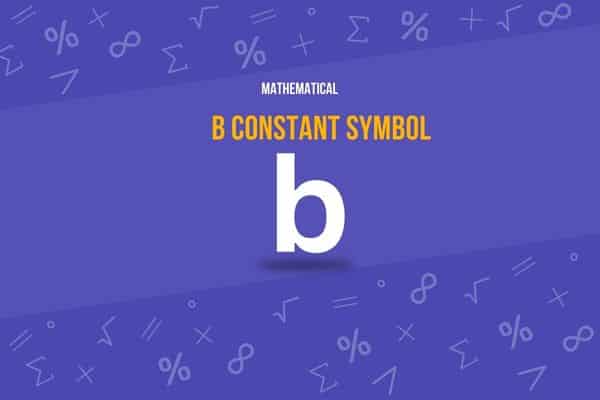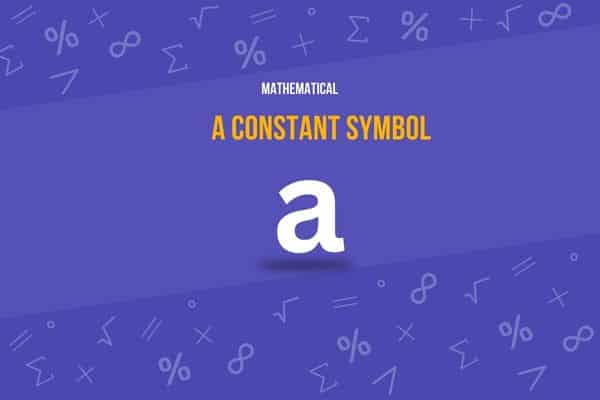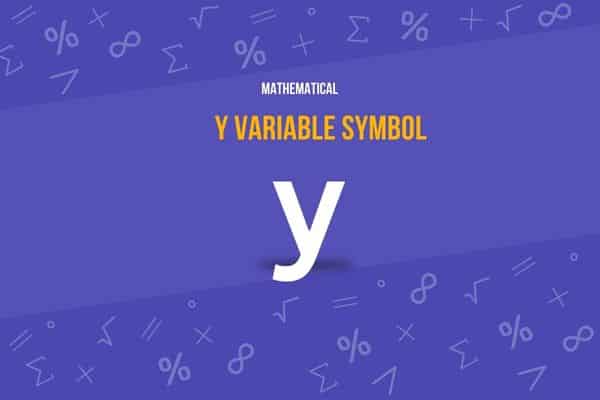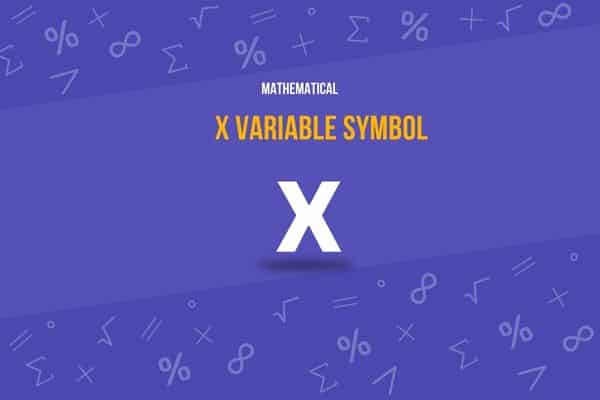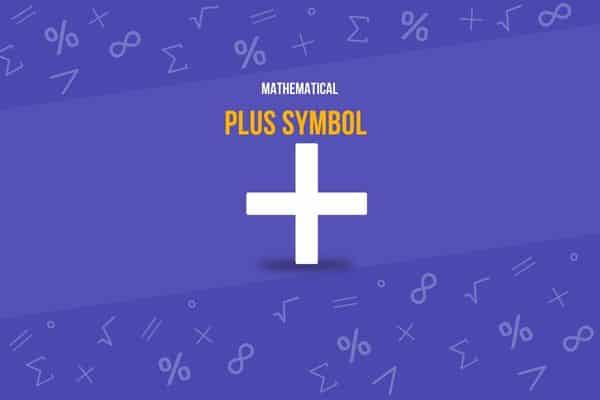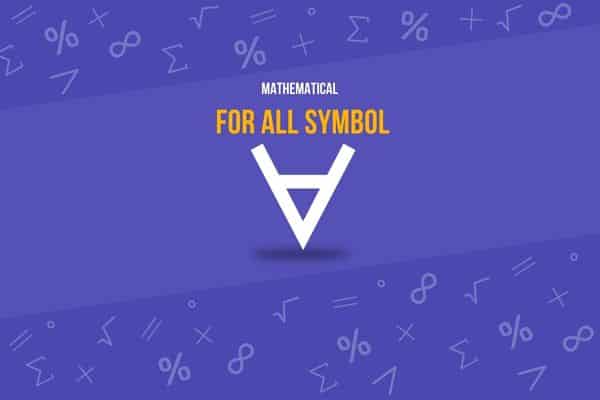What is the Not Element Of Symbol?
Have you ever glanced at a mathematical or logical expression and found yourself puzzled by a peculiar symbol resembling a stylized ‘E’ crossed out?
That is the “Not Element Of” symbol ( ∉ ), a fundamental symbol in set theory, a branch of mathematical logic dealing with collections of objects.
You’ll discover its meaning, uses, and the context in which it flourishes. We’ll also guide you through some examples to help you grasp how and when to use it.
By the end of this book, you will have a more profound understanding of this fascinating symbol and a newfound confidence in your ability to interpret it in future encounters.
So sit tight and prepare to illuminate a new corner of your mathematical knowledge.
Let’s get started!
Fast Facts
∉
Not Element Of Symbol
Not Element Of Symbol (∉)
Here’s a detailed table summarizing the key attributes of the “Not Element Of” symbol (∉):
| Attribute | Details |
|---|---|
| Symbol Name | Not Element Of |
| Unicode | U+2209 |
| Image | ∉ |
| Brief Description | Used in set theory to indicate that an element is not a member of a specified set. |
| Unicode Version and Date | Unicode 1.1, released in June 1993 |
| Unicode Block Name | Mathematical Operators |
| Plane | Basic Multilingual Plane (BMP) |
| Script | Common |
| Category | Symbol, Math |
| Bidirectional Class | Other Neutral (ON) |
| Combining Class | 0 |
| Character is Mirrored | No |
| HTML Entity | ∉ or ∉ |
| CSS | \2209 |
| UTF-8 Encoding | E2 88 89 |
| UTF-16 Encoding | 2209 |
| UTF-32 Encoding | 00002209 |
Here’s What You Will Find
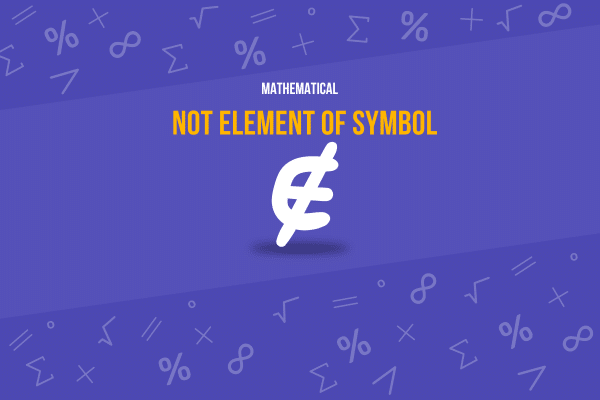
Not Element Of Symbol
The Not Element Of Symbol (∉) is a fundamental tool in set theory, a branch of mathematical logic that studies collections of objects called sets. This symbol is a variation of the element-of symbol (ε or ∈), which denotes that an item is part of a set.
By contrast, the Not Element Of Symbol (∉) signifies the opposite – that a specific item is not part of a given set. In other words, if you see “x ∉ A,” this statement is communicating that “x” is not an element or member of the set “A.” It’s a straightforward yet powerful way to express non-membership in mathematics.
Other Names
The “Not Element Of” symbol (∉) is primarily known by this name in mathematical contexts, where it is used to indicate that a particular element does not belong to a specific set. However, it can also be referred to by a few other terms depending on the context or the specific literature:
- Does Not Belong To – This phrase is often used in mathematical texts to describe the relationship between an element and a set when the element is not a set member.
- Not a Member of – Similar to “does not belong to,” this phrase is used interchangeably to express that an element is excluded from a set.
- Exclusion from a Set – While not a direct synonym, this phrase effectively communicates the meaning of the ∉ symbol in descriptive terms.
These variations help understand and explain the concept, especially in educational or introductory contexts where formal mathematical symbols might not be immediately familiar.
Regardless of the name, this symbol is a powerful tool in mathematics and logic. It allows us to express the absence of membership within a set and compare values or elements in various contexts.
Not Element Of Symbol Meaning
The “Not Element Of” symbol (∉) is a mathematical symbol used to denote that a specific element does not belong to a particular set. It negates the “Element Of” symbol (∈), which indicates that an element is a member of a set.
For example, if ( a ) is an element and ( S ) is a set, writing ( a \notin S ) expresses that ( a ) is not included in ( S ). This symbol is essential in set theory and mathematical logic for distinguishing between membership and non-membership within sets.
The “Not Element Of” symbol (∉) is used in mathematics, particularly in set theory, to denote that a particular element does not belong to a specific set. It’s essentially the opposite of the element-of symbol (ε or ∈), which indicates that an item is part of a set. When you see an expression like “x ∉ A,” it means that the element “x” is not a member of the set “A.”
This symbol plays a crucial role in distinguishing and clarifying the relationship—or lack thereof—between an element and a set.
Symbolism of the “Not Element Of” Symbol
The “Not Element Of” symbol (∉) carries significant symbolic meaning beyond its practical utility in set theory and mathematics. As a symbol, it represents the concept of exclusion and the boundaries that define whether elements belong to a specific set or category.
Symbolic Representation of Exclusion and Boundary
At its core, the (∉) symbol is a stark representation of exclusion. It denotes that a particular element does not share the characteristics or qualifications necessary to belong to a defined group or set. This can symbolize broader themes of differentiation and separation in various contexts—whether in mathematics, social sciences, or philosophical discussions.
Philosophical and Social Implications
Philosophically, the symbol invites reflection on the nature of categories and the criteria we use to include or exclude. It can serve as a metaphor for societal and cultural boundaries, where certain individuals or groups are considered “outside” the norm or mainstream. This aspect makes the symbol a potent tool for discussing social inclusion, identity, and diversity.
Educational and Cognitive Symbolism
In educational contexts, the (∉) symbol helps learners understand the importance of precise criteria in classification and categorization tasks. It emphasizes the need for clear definitions and boundaries when sorting elements into groups, a fundamental skill in logical reasoning and critical thinking.
Visual and Conceptual Contrast
Visually, the (∉) symbol also creates a direct contrast to the “Element Of” symbol (∈), highlighting the binary nature of membership. This contrast is not just a notational convenience but also a conceptual tool that illustrates the dichotomy between inclusion and exclusion—two fundamental forces that shape our understanding of sets and, by extension, the world around us.
Overall, the “Not Element Of” symbol (∉) is not just a mathematical notation but also a symbol rich with meanings that resonate in various intellectual and social spheres. It encourages a deeper consideration of what it means to belong and the impact of being classified as outside a designated set or group.
Not Element Of Symbol Unicode
Unicode is a universal character encoding standard that assigns a unique number, or “code point,” to each character used in written languages. This allows computers and digital systems to use, recognize, and process the characters. Unicode encompasses virtually all characters used in written languages worldwide and includes various symbols and other characters used in mathematics, music, and more.
The Not Element Of symbol (∉) is also included in the Unicode standard. Its Unicode is U+2209. This means it is listed as the 8,713th point in the Unicode standard (as Unicode begins at U+0000). So, wherever you are in the world, if you want to include the “Not Element Of” symbol in a digital document or message, you can use its unique Unicode, U+2209, ensuring it will be correctly displayed and understood by compatible systems.
Not Element Of Symbol Uses
The “Not Element Of” symbol (∉) is an essential mathematical operator in set theory, logic, and various fields that involve mathematical reasoning. Here are some primary uses of the ∉ symbol:
Set Theory
- Element Exclusion: This symbol is used in set theory to explicitly state that a particular element does not belong to a specified set. For example, if (S = {1, 2, 3}), then writing (4 \notin S) clearly indicates that 4 is not a member of set (S).
- Defining Complements: In describing the complement of a set, the ∉ symbol is used to identify all elements that are not part of the original set within a universal set.
Mathematical Logic
- Logical Statements: In logic, ∉ is used to formulate negations involving set membership. For example, the statement “If (x \notin A), then (x \in B)” is used to express logical relationships and conditions based on set memberships.
- Proofs and Theorems: The symbol is often employed in proofs, particularly in proving by contradiction or establishing the non-existence of certain elements within sets.
Computer Science
- Algorithm Design: Algorithms that involve data set operations frequently use ∉ to ensure certain elements are excluded from computations or iterations. This is common in algorithms dealing with unique sets of data or in conditional loops.
- Data Structure Operations: In programming, particularly when dealing with complex data structures like sets, graphs, or databases, the ∉ operator is used to check membership and enforce data integrity or constraints.
Database Management
- Query Conditions: In SQL and other query languages, the concept of ∉ is used when specifying conditions in a query to exclude records that belong to another set or result from a subquery.
Philosophy and Formal Semantics
- Semantic Analysis: In philosophical logic and formal semantics, the ∉ symbol helps clarify discussions about concepts, categories, and their memberships or non-memberships to certain logical or conceptual sets.
Education
- Teaching Set Concepts: Educators use the ∉ symbol when introducing students to basic and advanced concepts of sets and their operations, helping to differentiate clearly between inclusion and exclusion within sets.
These uses demonstrate the versatility of the ∉ symbol in expressing non-membership across various scientific, educational, and practical applications, making it a fundamental part of the language of mathematics and logic.
The Not Element Of Symbol (∉) is a key tool in mathematical expressions, specifically in set theory. It denotes the non-membership of an element in a particular set.
This means that when you encounter this symbol between two terms, like in “x ∉ A,” it states that “x” does not belong to the set “A.” Beyond just individual elements, this symbol can also articulate the relationship between two sets. For instance, if you have “A ∉ B,” it implies that set A is not a subset of set B.
This symbol is also employed in logical statements where you might want to express exclusion or absence. Its pervasive use across different aspects of mathematics makes it an essential component in the language of this field.
Not Element Of Symbol Examples
The “Not Element Of” symbol (∉) is widely used across various mathematical and logical contexts to indicate that a specific element does not belong to a particular set. Here are some practical examples to illustrate the use of this symbol:
Basic Set Theory
- Example: Suppose ( S = {1, 2, 3, 4} ) and ( T = {5, 6, 7} ). We can denote ( 5 \notin S ) to explicitly state that the element 5 is not a member of set ( S ).
Mathematics Education
- Teaching Tool: In educational settings, teachers use ( \notin ) to help students understand set membership by creating exercises where students must identify whether elements are part of given sets. For instance, given ( M = { \text{apple}, \text{banana}, \text{cherry} } ), students might be asked if “orange” is an element of ( M ), denoted by ( \text{orange} \notin M ).
Mathematical Proofs
- Proof by Contradiction: In a proof, a mathematician might assume that an element belongs to a set to lead to a contradiction. For example, assuming ( x \in A ) leads to a contradiction, hence proving ( x \notin A ).
Computer Science
- Algorithm Conditionals: In programming, the ∉ symbol might be used within algorithmic conditions to exclude specific elements from processing. For example, in a sorting algorithm, certain outlier values might be excluded explicitly using ( x \notin \text{Outliers} ).
Database Queries
- SQL Operations: In database management, queries might use the concept of ( \notin ) to exclude records. For example, selecting all customers who are not in a specific region might be expressed as:
SELECT * FROM Customers WHERE RegionID NOT IN (SELECT RegionID FROM Regions WHERE Name = 'East').
Logic and Set Operations
- Logical Reasoning: In formal logic, the symbol is used to describe conditions and propositions involving non-membership. For example, if being a student at a university implies having a university email, then ( x \notin \text{Students} ) could imply ( x ) does not have a university email.
Philosophical Arguments
- Category Exclusion: In philosophical discourse, ( \notin ) may be used to articulate that certain concepts or objects do not fall within specific categorical boundaries. For example, discussing whether certain actions ( a ) belong to morally permissible actions might involve stating ( a \notin \text{Morally Permissible Actions} ).
These examples demonstrate the utility of the “Not Element Of” symbol (∉) in providing clarity and precision in mathematical discussions, educational settings, computer programming, database management, and even philosophical reasoning, among other applications.
Let’s consider a simple set:
Let A = {1, 2, 3, 4, 5}.
This set, A, contains the numbers 1 through 5. If we take a number, let’s say 7, we can see that this number is not in set A.
This is where we would use the Not Element Of Symbol. We can express this non-membership as:
7 ∉ A
This is read as “7 is not an element of A”, expressing that the number 7 does not belong to the set A. This is a basic example, but it illustrates the primary use of the Not Element Of Symbol: to denote that a particular item is not a member of a specified set.
Why is the Not Element Of Symbol Important?
The Not Element Of Symbol (∉) is crucial in mathematics because it allows us to express the idea of non-inclusion or non-membership succinctly. This is particularly important in set theory, where understanding the relationships between different elements and sets is fundamental. Without this symbol, describing the concept of an element not being part of a set would be considerably more verbose and less clear.
Expressing exclusion or absence in logical statements is vital in building and interpreting mathematical proofs and arguments. Hence, the Not Element Of Symbol is a tool for efficiency and a key element in the precision and clarity of mathematical communication.
Not Element Of Symbol History
The Not Element Of Symbol (∉) and its counterpart, the Element Of Symbol (∈), are rooted in set theory, a branch of mathematical logic that emerged in the late 19th century. The German mathematician Georg Cantor is considered the founder of set theory. Still, it was another mathematician, Giuseppe Peano, an Italian, who in 1889 introduced the symbol (∈) to represent “is an element of.”
The “Not Element Of” symbol (∉) has an interesting history tied to the development of set theory and logical notation in mathematics. This symbol is critical for expressing non-membership within a set, a fundamental concept in many mathematical and logical disciplines.
Origins in Set Theory
Set theory was founded in the late 19th century by Georg Cantor as a formal branch of mathematics. Cantor introduced the concept of a set, a collection of distinct objects considered objects in its own right. Initially, the notation for membership (( \in )) was developed to express that an element belongs to a set, becoming a standard part of mathematical language. However, as set theory evolved, there was a clear need for a complementary notation to denote when an element is not a part of a set.
Development of Non-Membership Notation
The symbol for non-membership (( \notin )) emerged as a natural extension of the symbol for membership. Mathematicians started using ( \in ) with a stroke through it to indicate non-membership, drawing from the practice of negating a symbol by adding a line through it, which was already common in mathematical notation for other purposes.
Standardization and Formal Adoption
The use of ( \notin ) was standardized along with other mathematical notations in the 20th century, particularly as set theory became more integrated into the foundation of mathematics and logic. The notation was likely popularized by influential texts in set theory and logic, such as those by Bertrand Russell and Alfred North Whitehead in their seminal work Principia Mathematica, which laid out a comprehensive system of logic and mathematics.
Role in Mathematical Logic
As logical systems became more formalized, the distinction between belonging and not belonging to a set became crucial for constructing precise logical arguments, definitions, and proofs. The clarity and utility of the ( \notin ) symbol helped detail the properties of sets, functions, and relations without ambiguity.
Inclusion in Unicode and Digital Communication
With the advent of digital typesetting and computer science, the need to have a consistent representation for mathematical symbols across platforms led to the inclusion of ( \notin ) in the Unicode Standard. This ensured the symbol could be used universally in digital documents and programming languages, maintaining its role in modern mathematics and related fields.
The history of the “Not Element Of” symbol (∉) reflects broader trends in the evolution of mathematical notation. From its origins in set theory to its standardization in formal logical systems and eventual adoption in digital communication, ( \notin ) is a testament to the dynamic interplay between mathematical innovation and the practical needs of communication and computation in the sciences.
The cross over the symbol, creating the Not Element Of Symbol (∉), was a logical extension to indicate the opposite, “is not an element of.” These symbols have since become universally adopted in mathematical notation and remain integral to expressions in set theory and logic. They serve as a testament to the continual evolution of mathematical language to enhance precision and efficiency in expressing complex ideas.
Not Element Of Symbol Origin
The Not Element Of Symbol (∉) originates from the development of set theory, a fundamental branch of mathematical logic that emerged in the late 19th century. The “Element Of” symbol (∈), upon which the “Not Element Of” symbol is based, was introduced by Italian mathematician Giuseppe Peano in 1889.
He used this symbol to represent the concept of an element belonging to a set. Adapting to the “Not Element Of” symbol (∉) was a natural extension, incorporating a slash across the original symbol to indicate the inverse relationship, i.e., an element not belonging to a set. Ever since its introduction, the symbol has become a staple in mathematical expressions, especially those about set theory and logical statements.
The origin of the “Not Element Of” symbol (∉) is closely linked to the development of set theory and the need for precise mathematical notation to express the concepts of membership and non-membership within sets.
Origins in Set Theory
Georg Cantor primarily developed set theory, the mathematical study of sets and their properties in the late 19th century. Cantor introduced the concept of a set as a collection of distinct objects and defined various operations on these sets. To describe whether an object is a member of a set, the “Element Of” symbol (∈) was introduced.
Introduction of Non-Membership Notation
As set theory evolved, a need arose to clearly express when an element does not belong to a set, particularly as mathematicians began to explore more complex set operations and relationships. The “Not Element Of” symbol (∉) was devised as a straightforward modification of the existing “Element Of” symbol (∈), by adding a simple slash through it. This typographic design followed the common mathematical practice of denoting negation by striking through a symbol, an intuitive method to signify the opposite or the absence of a property.
Standardization and Formal Adoption
The symbol was formalized and widely used in the early 20th century as textbooks and academic papers on set theory began to increase. The precise origin of who first used the symbol isn’t well-documented, much like many other mathematical symbols that evolved organically in scholarly communications. However, its adoption was certainly driven by the need for clear and concise notation in mathematical discourse, which was rapidly formalizing during this period.
Role in Mathematical Texts
Iconic mathematical texts and foundational courses in logic and mathematics, including set theory, likely helped standardize and propagate the use of the (∉) symbol. Its utility in expressing logical negation in set membership made it an essential part of the mathematician’s toolkit.
Modern Usage
Today, the (∉) symbol is universally recognized in mathematical and logical expressions and is included in Unicode, allowing for consistent digital representation. It remains a fundamental part of the notation in mathematics, computer science, and fields that rely on precise logical expressions.
In summary, the “Not Element Of” symbol (∉) originated from the practical requirements of set theory and mathematical logic, embodying the evolution of mathematical notation toward greater clarity and efficiency. Its design is a simple yet powerful example of how mathematicians adapt and create symbols to meet the needs of their disciplines.
Evolution of the Not Element Of Symbol
The Not Element Of Symbol (∉) has maintained its core design and meaning over time. Its basic form, a stylized ‘E’ with a diagonal slash, has remained consistent.
However, its adoption and recognition have evolved with the advancement of mathematical notation and computer systems. In the early days, mathematical symbols were handwritten or typeset manually, leading to slight variations in appearance. With the rise of digital communication and the standardization of character encodings like Unicode, the symbol has become more uniformly represented across different platforms and fonts.
This ensures its consistent and recognizable use in modern mathematical discourse. While the core concept of the symbol remains unchanged, its accessibility and consistency have been enhanced by technological advancements.
Not Element Of Symbol In Everyday Life
Personal reflections on the Not Element Of Symbol (∉) evoke a sense of precision and clarity in my daily routines. Its representation of non-membership encourages me to evaluate the various aspects of my life and identify what doesn’t align with my values, goals, or well-being. It prompts me to discern the elements, activities, and relationships that do not contribute positively to my personal growth or happiness.
By applying the principles of the Not Element Of Symbol, I can consciously exclude those factors from my routines and focus on nurturing the ones that bring me joy, fulfillment, and progress. This reflection allows me to streamline my commitments, prioritize my time and energy, and make choices that align with my values, resulting in a more purposeful and balanced daily life. In this way, the Not Element Of Symbol principles can guide me toward a more intentional and satisfying existence.
Last Thoughts
The Not Element Of Symbol (∉) plays a vital role in mathematical language, specifically set theory and logical expressions. Its representation of non-membership provides clarity and precision when communicating about elements and sets.
While its influence in popular culture may be limited, exploring various symbols and signs can be intriguing. If you are captivated by the world of mathematical symbols, we encourage you to explore and discover other fascinating signs that contribute to your understanding of complex concepts.
You might even stumble upon merchandise or products that celebrate the beauty and significance of these symbols, including the Not Element Of Symbol. So, embrace the allure of mathematical symbols, explore further, and perhaps you’ll uncover a newfound appreciation for the intricate language of mathematics.
Before You Go?
As you’ve explored the intriguing world of the not element of symbol, don’t stop there; continue your journey by exploring the fascinating stories and meanings behind other mathematical symbols and see how they illuminate our understanding of the universe around us. Expand your horizons and explore the vast array of symbols that enrich our understanding of the world.
If you found this discussion about the “Not Element Of” symbol (∉) intriguing, share this post with your friends or colleagues to spark a conversation about the fascinating world of mathematical symbols and their broader meanings in society and culture!

